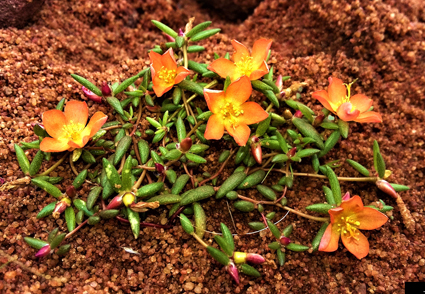Abstract
Portulacaceae is a monogeneric family with a genus Portulaca comprising more than 150 species worldwide. In India, it is represented by 11 taxa of which three species are endemic. Portulaca tuberosa is a polymorphic species distributed in the Indian subcontinent to North Australia. During revisionary studies of the genus, authors collected different populations of P. tuberosa from India with different morphotypes. Detailed studies were carried out on the variation of P. tuberosa with the pictorial presentation. Furthermore, P. badamica is much distinct species in Clade-Pilosa despite this, misleadingly some workers synonymized the species under P. tuberosa. However, morphological, molecular, and SEM studies show P. badamica and P. tuberosa are unrelated and distinct species. The present work also highlights the variation in P. tuberosa which will avoid further confusion while describing the new taxon as well as the reinstatement of P. badamica from P. tuberosa with the help of all supportive data.
References
- Dalavi, J., Deshmukh, P., Jadhav, V. & Yadav, S. (2018) Two new species of Portulaca (Portulaceae) from India. Phytotaxa 376 (1): 068–076. https://doi.org/10.11646/phytotaxa.376.1.7
- Dalavi, J.V., Chougule, R.N., Jadhav, V.D. & Yadav, S.R. (2019) Variation in Seed Micromorphology in Portulaca L. (Portulacaceae) in India. Phytomorphology 69 (1–2): 15–24.
- Hooker, W.A. (Ed.) (1829) Curtis’s Botanical Magazine, vol. 56. Royal Botanic Gardens, Kew, without pagination.
- Jain, S.K. & Rao, R.R. (1977) A Handbook of Field and Herbarium Methods. Today & Tomorrow’s Printers and Publishers, New Delhi, 130 pp.
- Ker Gawler, J.B. (1824) Botanical Register; Consisting of Coloured Figures of Exotic Plants Cultivated in British Gardens; with their History and Mode of Treatment, vol. 10. James Ridgway, London, 868 pp.
- Linnaeus, C. (1753) Species Plantarum, vol. 1. Impensis Laurentii Salvii, Holmiae, 590 pp.
- Miller, M.A., Pfeiffer, W. & Schwartz, T. (2010) Creating the CIPRES Science Gateway for inference of large phylogenetic trees. Proceedings of the Gateway Computing Environments Workshop (GCE), New Orleans, LA, pp. 1–8. https://doi.org/10.1109/GCE.2010.5676129
- Ocampo, G. & Columbus, J.T. (2012) Molecular phylogenetics, historical biogeography, and chromosome number evolution of Portulaca (Portulacaceae). Molecular Phylogenetics and Evolution 63: 97–112. https://doi.org/10.1016/j.ympev.2011.12.017
- Phillips, S.M. (2000) Notes on Portulaca L. (Portulacaceae) in Tropical East Africa. Kew Bulletin 55 (3): 687–698. https://doi.org/10.2307/4118786
- POWO (2024) Plant of the World Online. https://powo.science.kew.org/ (accessed 21 September 2024).
- Ronquist, F. & Huelsenbeck, J.P. (2003) MRBAYES 3: Bayesian phylogenetic inference under mixed models. Bioinformatics 19: 1572–1574. https://doi.org/10.1093/bioinformatics/btg180
- Roxburgh, W. (1832) Flora Indica; or descriptions of Indian Plants, vol. 2. Mission Press, Serampore, 464 pp.
- Singh, R.K. & Arigela, R.K. (2022) Taxonomic notes on southern Indian Portulaca (Portulacaceae). Feddes Repertorium 133 (2) 128–140. https://doi.org/10.1002/fedr.202100010
- Sivarajan, V.V. & Manilal, S.K. (1977) Taxonomic Notes on Portulaca oleracea Linn. in India. New Botanist 4: 30.
- Sivarajan, V.V. (1981) Taxonomic notes of the genus Portulaca Linn. from India. Journal of Bombay Natural History Society 78: 256–260.
- Stamatakis, A. (2014) RAxML version 8: A tool for phylogenetic analysis and post-analysis of large phylogenies. Bioinformatics 30: 1312–1313. https://doi.org/10.1093/bioinformatics/btu033
- Tamboli, A.S., Dalavi, J.V., Kadam, S.K, Yadav, S.R., Govindwar, S.P, Choo, Y.S. & Pak, J.H. (2022) Molecular Phylogenetic Evidence and Biogeographic History of Indian Endemic Portulaca L. (Portulacaceae) Species. Diversity16 (4) 443: 1–16. https://doi.org/10.3390/d14060443
- Wight, R. (1834) Prodromus Florae Peninsulae Indiae Orientalis: Containing abridged descriptions of the plants found in the peninsula of British India, arranged according to the natural system, vol. 1. Parbury, Allen & Co, London, 356 pp.


